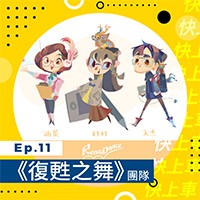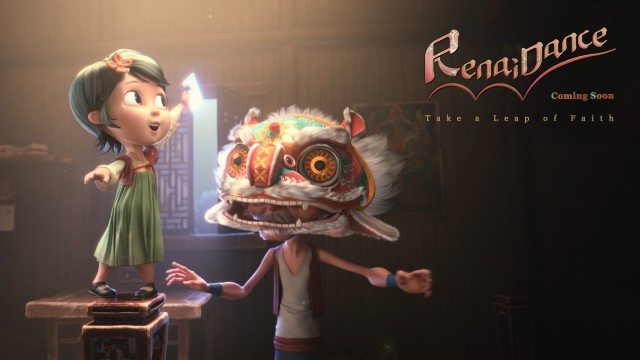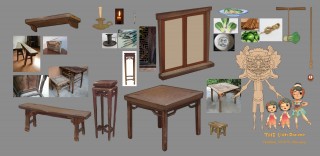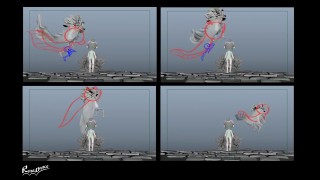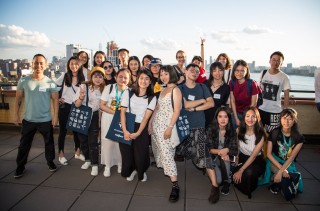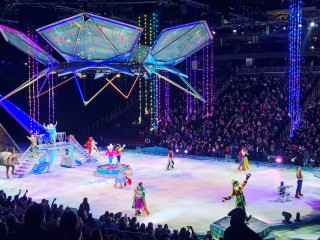By accepting you will be accessing a service provided by a third-party external to https://www.incgmedia.com/
【發車啦!畢製老司機】EP.11 就讀紐約視覺藝術學院!前往迪士尼實習!與《RenaiDance 復甦之舞》團隊暢談旅外之路
發車啦!畢製老司機】 第 11 集邀請到就讀於紐約視覺藝術學院 SVA 三位學生-楊芝科、張涵蓁、吳文杰。除了暢談動畫短片《RenaiDance 復甦之舞》的創作理念與製作過程,他們也分享在 SVA 的學習經驗。值得一提的是,三位當中有人並非純動畫系學生,以自學歷程順利展開紐約的動畫夢,逐漸成為一位優秀的前期故事藝術家;有人則在經歷 CG 藝術家的背景後,受自藍天工作室的指導教授啟發,從中找到自己真正的天賦-創意動畫製片;有人則始終懷抱動畫夢,成功進入迪士尼動畫工作室,成為全球被選中的五名實習生之一,完成了優秀的動畫短片。話不多說!馬上來了解他們的冒險旅程!
Welcome back to InCG Media Podcast program! For the eleventh episode today, it is a pleasure to invite three talented students, Zhike Yang, Han Chen Chang, and Wenjie Wu, from School of Visual Arts, New York. With the creative concept and production process of the animated short film "RenaiDance", they also shared their learning experience at SVA MFA Computer Arts.
It is worth mentioning that each of them has a unique different background before entering the Master school in New York. One of the three students, Zhike Yang, who was not major in the animation field, has successfully developed her animation dream in New York through hard self-study and work experience. Besides, the animation dreamer, Han Chen Chang, inspired by the professor from Blue Sky Studio, realizing her authentic creative talent in animation production management. Furthermore, an animated technical addict, Wenjie Wu, who always embraces the dream of animation, successfully entered into Walt Disney Animation Studio, became one of the extraordinary five selected interns in the world, completed the excellent animated short film "Maestro". And so, without further ado, let's join their adventure in New York right away!
本集 Podcast 重點:
04:43 就讀 SVA 的原因
12:10 動畫《RenaiDance 復甦之舞》的創作分享
25:38 疫情下的紐約生活
43:26 實習經驗談
👉👉喜歡這集節目,想聽聽更多業界人士分享經驗,歡迎到 Spotify、Apple podcast 等網站訂閱【發車啦!畢製老司機】節目。
Highlights of this podcast episode:
04:43 The particular reasons for studying at School of Visual Arts
12:10 The inspiration of the animated short "RenaiDance"
25:38 New York life under the epidemic
43:26 Internship experience sharing
If you like this episode with interest in having more content from other talented people in the industry, please subscribe us on Spotify and Apple podcast program!
由紐約視覺藝術學院 SVA MFA Computer Arts 三名學生共同合作。
楊芝科(中):《復甦之舞》的創意導演。熱忱於故事創作與藝術概念,藉由視覺話最深入人心的故事,將悄悄向你透漏說故事的秘密。
吳文杰(右):《復甦之舞》的技術導演。2020年,於華特迪士尼動畫工作室擔任CG 實習生,將帶給我們迪士尼動畫樂園的冒險經歷。
張涵蓁(左):《復甦之舞》的創意製片。藉由項目管理與製作,以不同的視野
維度帶領你進入動畫世界,從中挖掘每個人的人生意義。
The team of "RenaiDance" team is collaborated by three talented students from MFA Computer Arts at the School of Visual Arts in New York.
Zhike Yang (center): The Creative Director of "RenaiDance".
Passionate about story creation and artistic concepts, by visually telling the most emotional stories, she will secretly tell the secret sauce of the excellent story structure.
Wenjie Wu (right): The Technical Director of "RenaiDance".
Honorably serving as a CG intern at Walt Disney Animation Studios in summer 2020, will bring us the fantastic adventures of Disney Animation World.
Han Chen Chang (left): The Creative Producer of "RenaiDance". Through project management and creative production, she will lead you into the beautiful animation universe with different dimensions, inspiring to dig out everyone's extraordinary meaningful life.
就讀紐約視覺藝術學院 SVA 的原因?
Why did you choose to study at School of Visual Arts in New York?
吳文杰:我大學就讀銘傳大學數位媒體設計系,在學習過程中,也逐漸發現自己想從事的方向-創作更龐大、精緻的專案。於是老師們建議我出國留學,不僅能開廣視野,還能建立人脈,進而加入國外大型的動畫工作室,實現我的理想。
張涵蓁:當時我只報考了 SVA,主要是因為學校所教授的動畫課程範圍廣,不會要求學生只專研動畫領域中的一、兩項技能(例如 Rig、model、lighting),因此我可以探索更多不同領域的藝術,並尋找自己的就業方向。而在就讀 SVA 後, 相較於歷年 CG 藝術家的技能,發現自己在創意製作與管理的天賦潛能。相信自己能運用統整企劃以及溝通協調力,帶領團隊一同在動畫中實踐夢想。
楊芝科:我從小就熱愛動畫,一直對奇幻的世界觀與故事有著濃厚的興趣。儘管後來就讀平面設計,卻受「故事創作」深深吸引。在看到《冰雪奇緣》後, 我下定決心往動畫行業邁進。於是開始自學動畫,從圖書館以及網路資料開始學習。過了一年多後,有了基本動畫知識、累積了一些人脈,剛好跟一間工作室合作平面設計,幸運地加入動畫團隊(當時真的沒想過,能在因緣際會下接觸動畫行業)。而在動畫製作過程中,我逐漸發現自己對於動畫前期,也就是劇 本、角色設定等方向有著更濃厚的興趣,於是我從美術轉變為動畫前期的創作者。這也是我為何就讀 SVA,並選擇成為一位故事藝術家(創意導演)的原因。
Wenjie Wu: I studied at the Department of Digital Media Design at Ming Chuan University in Taiwan. During the challenging learning process, I gradually discovered my ambition to create grand and more polished projects as my life achievement. In the view of professors' helpful suggestions to study abroad, I can broaden my vision with wider connections globally. Finally, I may get the opportunity to join an influential animation studio to accomplish my ideals.
Han Chen Chang: SVA MFA Computer Arts Department was my only choice two years ago. Mainly because of the school's great teaching policy with a wide range of courses. It does not require students to specialize in one or two skills in the field of animation (such as Rigging, Modeling, Lighting... and the like). Thus I can explore more in different areas and also seek the employment direction in the industry. After studying at SVA, compared with the skills of CG artists over four years, I found my talented potential in creative production and project management. I believe that I can apply my progress skills of well-organized planning and effective communication, to coordinate in various collaborations, eventually leading the team to the next level of our dreams in animation.
Zhike Yang: I have loved animation since I was a child, and I have always been interested in fantasy world views and stories. Although I later studied graphic design, I was always deeply attracted by "story". After watching "Frozen", I made up my mind to move forward in the animation industry. Starting to study animation on my own, self-learning from the library materials, and endless searching on the Internet. After more than a year, with the essential animation knowledge and connection, I happened to collaborate with a studio on graphic design and luckily joined the animation team (I had never expected it at that time.) In the process of animation production, I gradually found that I had a more substantial interest in the pre-production of animation, that is, the script, storyboard, character sets, and other related fields about the story. Therefore, I transform my life direction from concept art to the creator of pre-production in the animation industry. That is why I studied at SVA and chose to become a story artist, also the creative director in our film.
分享《RenaiDance 復甦之舞》創作理念
Please share the inspiration and creative process of "RenaiDance"
楊芝科:當時原本是想將另一個故事變成畢製,《復甦之舞》原本是作為畢製外的小短片作品。然而後來發現這個故事在當初的狀況下更具有可行度與發展性,因此轉而著手進行《復甦之舞》的動畫製作。而在發想故事時,剛好在紐約會舉辦作品放映會中,從來自世界各地的短片中激發了許多靈感。而後我幾乎每個月都會去觀賞,不斷被各種創作刺激,了解到了從題材、故事情節推動到結局的安排,可以有不同手法操作,更進而開展了對於動畫故事多方位拓展。也造就我們改變了原來的故事概念-爺爺因舞獅與女孩相遇,最終卻再也無法與女孩相見,藉由別離來呈現最深刻的傳承與親情情感。
當時這個故事只有概念,卻缺乏了成串連整理的核心-情感。所以我們開始去認識這兩個角色,試圖去挖掘他們之間的關係,進一步去開展情節。另外,原先僅有「文化傳承」的概念,它雖能體現亞洲近代對於傳統文化遺失的狀態,但這個概念在故事中可能略顯得單調,於是我們更添加芭蕾舞的設定,賦予小女孩自身的想 法,進而與傳統文化產生了文化衝突的戲劇張力。最終我們從衝突高潮中逐漸取得平衡,在結尾以感人的情緒達成合一,就此發展成一篇關於親情、探討文化融合的動人故事。
Zhike Yang: We originally intended to produce another story as our thesis project. "RenaiDance" was originally a short film for practice. However, we later discovered that this story was more feasible and developmental under the tight schedule and budget. Finally, we turned to focus on the animation production of "RenaiDance".
When thinking of the story, it happened that the "ANIMATION NIGHTS NEW YORK (ANNY)" held screenings monthly with plenty of great animation works, those amazing short films from all over the world always inspired me pretty much. I attend the screenings almost every month and continuously stimulated by various fabulous creations. I have learned that the arrangement from the theme and the storyline to the ending can operate in multiple different ways, and further developed a multi-faceted expansion of the animation story. The experience also caused us to change the original concept story of "RenaiDance": Grandpa meets the little girl because of the lion dance, yet they eventually separated for the lion dance as well, showing the most profound inheritance and family affection through the emotional farewell.
At that time, the story had only concepts, lacked the core of the series-emotion. We started to recognize these two characters, trying to tap the relationship between them, and further develop the plot.
Also, there was only the concept of "cultural heritage" in the very beginning. It can reflect the state of traditional culture lost in modern Asia as we planned; however, the concept may be slightly monotonous in the story. So we added the conflict setting of contemporary ballet on the little girl. In turn, the idea produced a dramatic tension in cultural conflict with traditional and modern culture. In the end, we gradually achieved balance from the climax of conflict. In the end, we reached an integration with touching emotions, which developed an inspiring story about family love and cultural integration.
針對故事其他兩位組員有甚麼想法嗎?
Other thoughts of the story in any aspect?
張涵蓁:《復甦之舞》不只是文化衝突,而是想藉由這個概念去讓人思考文化融合、文化傳承的意義。除了動畫想傳達出的情感,我們也希望更多藝術家看到後, 可以去創作屬於自己文化的內容。也同樣希望我們的觀眾能藉由我們的故事,因此反思自己的人生故事。每個人都可以是自己人生的創作者,創作者們以藝術為語 言,而當世界越來越多不同文化的藝術後,就可能擦出更多創意的火花,包容接納彼此的不同,激發出更多創造的可能性。
吳文杰:不論是芭蕾舞還是舞獅,其實都是在歷史上傳承已久的活動,之所以能不斷被留下,進而成為某種文化的象徵,就是因為這些活動帶給人們一段又一段的美好回憶,比方說小時候爸媽會帶我們去燈會,於是每年這個時刻,我都會想做一些元宵會做的舉動,以此重溫當時的回憶。所以文化跟情感是擺在一起的,而《復甦之舞》就是想傳達這層連結的創作。
Han Chen Chang: "RenaiDacne" presents not just a cultural conflict, but implying a concept to make people think about the meaning of cultural fusion and cultural heritage. In addition to receiving the emotions of the animation, we hope that more artists and creators can create the unique contents of their own cultures after watching "RenaiDance". We also hope that our audience can reflect on their personal life stories through our stories. Everyone can be the creator of his / her own life. The creators create their lives by applying art as the language. When more and more arts with different cultures in the world, they may spark more creative sparks. By accepting and integrating the wonderful differences, we all can inspire more creative possibilities.
Wenjie Wu: Whether it is ballet or lion dance, it is a fascinating culture that has inherited for a long time in history. The reason why it can continue to exist and become a symbol of a culture is that those bring people uplifting memories after another. For instance, my parents would take me to the Lantern Festival when I was a kid. Since then, I love to participate in Lantern Festival every year at a particular time, which always relives the beautiful memories with my family at that time. To sum up, culture and emotion come together beautifully always. "RenaiDance" is intended to convey the creation of this connection.
對於傳統文化,團隊成員有做什麼考究?
For the traditional culture, can you please show your research?
楊芝科:《復甦之舞》中的某些片段,源自於我的童年記憶。像是山中屋子裡掛滿了樂器的畫面,是小時候長輩在過節以外的時間,會把一些打擊的傳統樂器放在牆角,以便節慶或是需要用到時可以馬上使用。在親戚小孩過來探訪,長輩會從牆上拿一些樂器,與小孩一同敲打、玩耍。有一年我回老家時,看到一群人敲鑼打 鼓,裝扮成舞獅,挨家挨戶去送吉祥,覺得活動非常有趣。而我爺爺卻總會看著牆上的樂器嘆氣,雖然不理解其中的原因,但感覺上背後有一個難以述說的故事,於是我們借用這份回憶,運用在《復甦之舞》上。
另外,在美術道具的設定或是繪製上,團隊成員也找了很多資料作為創作的參考, 畢竟 3D 動畫其實是無死角的,如果稍有一個地方跟傳統文化不相符,就會讓人出戲。舉例而言,獅頭的造型就有分「北獅」與「南獅」,於是我們就要先設定好主人公的背景,才能開始製作模型並畫貼圖。最終我們選擇了「南獅」,主要是因為它的色彩比較絢麗,也有用來裝飾的白色毛絨,跟芭蕾舞衣的白色裝飾有相似之 處,可以作為兩個文化之間的連結,使「文化融合」的命題能以視覺呈現。
吳文杰:在前期設計完,進入製作階段,我們開發了許多 Pipeline,讓一些傳統文化的裝飾,能在動畫中看起來更真實,更有傳統文化之美。於是不論是模型、材質、燈光渲染,我們都會盡力去嘗試,進而定義出最接近傳統文化的樣貌。我個人最喜歡的元素就是「3D 刺繡」,雖然許多動畫電影中,都有嘗試創作刺繡圖案,但看起來都少了東方文化的美感。因此這次我找了許多刺繡圖騰的參考,希望能把東方特有的美學融入其中。技術 上,我用了 Substance Designer 搭配我們研發的工具,讓刺繡的圖案能變成 3D 圖像,節省許多創作時間,這個經驗也讓我收穫滿滿,也更堅定自己要往 3D 動畫技 術這條路邁進。Zhike Yang: Some of the pieces in "RenaiDance" came from my childhood memories. The house in the mountain is full of traditional musical instruments. The elders would put some conventional percussion instruments on the corners of the old house, so that they can be used immediately during festivals or whenever they needed. When relatives and children came to visit, the elders will take those musical instruments and beat and play with the children. Once, I returned to my hometown, appreciating a group of people played gongs and drums, dressed up as lion dancers, and went door to door to send auspicious gifts. I found the activity very interesting. However, my grandfather always looked at the instruments on the wall with deep, meaningful sighs. Although I didn't understand the reason, I felt that there was an incredible story behind it. Therefore, we borrowed this memory and applied it in "RenaiDance".
Besides, we researched a lot of materials as references for the interior & exterior settings, as well as every prop and item. After all, 3D animation unfolds an animated world in 360 degrees. Even a tiny point that does not match the cultures, it leads to uncertain error. For example, the shape of a lion head divides into "North lion" and "South lion", thus we need to set the background of the protagonist before we can start to create models and textures. In the end, we chose "Southern Lion", mainly because of the gorgeous colors with the white plush for the decoration, which are similar to the white decoration of ballet dresses, becoming a perfect connection between the two different cultures. This is the best example with the proposition of "cultural integration" can be visualized.
Wenjie Wu: After the preliminary design and entering into the 3D production, we have developed many original pipelines to make the traditional cultural decorations more realistic with cultural aesthetics in animation. No matter the models, materials, or lighting renderings, we try our best to define the appearance that is the closest to traditional culture. Personally, my favorite element is "3D embroidery". Although many animation movies have been attempting to create embroidery patterns, they seem to lack the beauty of Asian culture.
SVA 讓你印象深刻的課程?
The most impressive courses at SVA?
張涵蓁:我們學校蠻多課程都可以旁聽,但我印象深刻的是請了四位 BlueSky 的藝術家,教導我們如何創作在戲院戴 3D 眼鏡看到的立體效果,也就是將影像轉為實體的 3D。它可以使用 Photoshop、Maya、Nuke 等軟體去製作。這堂課讓我理解到, 原來要一個 3D電影,可以這麼多創作的方式以及合作模式呈現。每一種方法都可以由擅長不同領域的藝術家所教,像是作為燈光師,要如何在 3D 電影上利用光線打來塑造層次;或是作為合成師,該如何多方位打造出不同維度的效果。這讓學生可以跟業界人才接軌,去學習真正會用到業界的知識,同時開拓我的視野,了解技術、創作相互作用下能產生甚麼樣的可能性。
另外,學校也會開辦 Individual Meeting,也就是一對一的指導課程。這對交換生來說,是一大助益。首先,它能訓練我們的溝通能力、幫助我們理解美國的溝通文化,讓我們更有自信地講英文,不論是與其它藝術家合作或是求職面試,都會需要Individual Meeting。因此開辦這類教學模式,有助於交換生更融入當地。甚至學校也會邀請一些業界人士(也可以自己尋找),根據創作、職涯方向給我們建議,讓我們更能理解產業資訊,無痛進入產業,進而累積一些人脈,挖掘潛在地合作契機, 我也因此得以認識幾位 Netflix 的產業人士,並有幸與他們共同合作。
Han Chen Chang: There are a lot of courses in our school that take or audit, but I am impressed by the 3D Stereoscopic course with four professional mentors from BlueSky Studio. The course is about how to create the 3D effect seen in the theater wearing 3D stereoscopic glasses, that is, turning the image into a real 3D with our works. 3D Stereoscopic technique can apply with Photoshop, Maya, Nuke, and other software. This lesson made me understand that 3D movie that could present in so many creative ways and cooperation modes. Each method is nicely taught by the mentors who are good at different fields, such as how to use lighting to shape layers in a real 3D movie as a lighter, or how to create different dimensions of effects in multiple directions as a compositor. These allow students to connect with industry talents to learn what will require in the industry, in the meantime time, broaden our vision to understand the possibilities to arise under the interaction of technology and creativity.
In addition, the school usually runs an Individual Meeting, which is a one-to-one guidance course. This is a great benefit for international students. First of all, it can train our communication skills, help us understand the communication culture in the United States, and make us speak English more confidently. Whether it is cooperation with other artists or job interviews, Individual Meeting is significant as always. Therefore, the establishment of this kind of teaching model will help exchange students to integrate into the local area. Even the school will invite some people in the industry (you can also find it by yourself) to give us suggestions based on the direction of creation and career. So that we can better understand the industry information, enter the industry painlessly, and then accumulate some contacts and tap potential opportunities for cooperation. As my example, I was able to meet several Netflix industry professionals and have the opportunity to work with them.
聊聊去國外動畫公司實習的經驗?
Talk about your internship experience in foreign animation companies?
吳文杰:此次去迪士尼實習,給我最大的收穫就是,從中了解到迪士尼結合技術與藝術的動畫生產流程。例如說,迪士尼的技術人員會與動畫師溝通,談談有甚麼創作上的需求,藉此開發數以萬計的小工具、小程式,幫助動畫師做出更精緻的畫 面,像是迪士尼獨一無二的無 UV 貼圖技術-Ptex,雖然該技術歷史悠久,但唯有迪士尼能把該技術活用到出神入化,不斷提升動畫貼圖的精細度,讓觀眾得以享受更加炫麗、精美的電影畫面。另外,就是可以打開《冰雪奇緣》等經典動畫電影的專案檔,來觀摩迪士尼藝術家是如何創建的。而部分迪士尼實習生最後還一起合 作,創建了動畫短《Maestro》,登上迪士尼的官網以及世界各地的社群平台,對於迪士 尼實習生來說,這樣的機會簡直千載難逢。
Wenjie Wu: My internship at Walt Disney Animation Studio is incredible! I obtained Disney's animation production process, fabulously integrating advanced technology and Disney 's aesthetics. For instance, the technical engineers usually communicate well with the production team about any creative needs. To develop tens of thousands of toolkits and programs to assist the team in creating more exquisite pictures, such as Disney's original Ptex's UV-free texture technology. Although the technology has existed for a long time in the animation industry, only Disney can apply this technology to the next level amazingly, continually improving the fineness of the texture in animation, so that the audience can enjoy more vivid and exquisite movie pictures.
In addition, it is possible for Disney Intern to open the project files of classic animated films such as "Frozen", to get to know how exactly Disney artists created them. Last but not least, as the Disney Interns, it was our job to create the animated short film "Maestro" in the nice collaboration, which has appeared on Disney's official website all over the world. For Disney interns, this is such a rare opportunity in our lives.
張涵蓁:動畫界裡有各種合作的形式與風格,你可以以各種專才才能進入迪士尼公司,也可以在世界各種風格的公司來實踐自己的動畫夢。舉例來說,如果要成為動畫製片(或其他動畫創作者),我們也可以選擇其他優秀的創意工作室。我曾實習的 1stAveMachine,在亞洲並不知名,然而,但它在西方各地都有其分部,接收世界各地的案子,(比如說Google, Facebook, Apple, Samsung等大公司的廣告案),以實拍、動畫、複合媒體、AR/ VR的形式來拓展,是具有影響力的廣告公司。而身為製片實習生,我要學的就是管理專案時程,在客戶與藝術家間進行溝通協調,將創意在各部門間做整合與進行。整個實習期間讓我最驚訝的是,協助藝術家訂午餐、點心,這種看似雜事的工作,居然是製片主管在負責!這不表示整個產業都是如此,每間公司依文化不同也會有不同的分工。但使當初的我體會到了一件重要的人生觀:製片最重要的工作,就是除了自我管理與自律能力,並照顧好每一位藝術家,整合團隊向心能力,一起一步步完成各項挑戰,在產業中踐共同的理想與抱負。
Han Chen Chang: There are various forms and styles of cooperation in the animation industry. You can enter Walt Disney Company with all kinds of expertise, and you can also practice your animation dream in various style companies in the world. Here are some examples, if someone wants to become an animation producer (or other animation creators), he or she can also try to work in other great creative studios. 1stAveMachine, which I used to work as an intern, is not well-known in Asia. However, it has branches in the West and accepts cases from all over the world (for instance, several advertising cases from large companies such as Google, Facebook, Apple, Samsung, etc.) It is an influential advertising company that expands in various forms of live-action, animation, mixed media, AR/ VR, and the rest. As a producer intern, what I got to learn is to manage the project schedule and budget, coordinating and communicating well between the clients, vendors. By integrating and executing the creative production between the various departments and artists, I was able to enhance my project management skill with worthwhile networking with people. What surprised me the most during the internship was that the seemingly chores jobs might complete by the influential person. Such as the lunch issue was actually the production supervisor in charge! This does not mean that the entire industry is in the same pattern, and each company will have a different division of labor according to different cultures. But at the perfect timing, I realized an essential point of life: the most critical job of project management is self-management and self-discipline ability. Always keep in mind to take good care of the whole company and every artist flexibly, even the significant job seems not like a big deal. In addition, integrating the team's centripetal ability and complete various challenges step by step. Eventually, realize the ideal vision with the company and thrive together in the industry.
談談故事藝術家這類前期工作,在美國的產業現況是如何?
What is the current status of the industry in the United States about the pre-production as a story artist?
楊芝科:由於前期製作是比較需要溝通、磨合,通常大型的動畫或創意公司, 會擁有一批固有團隊,因此成員流動不頻繁,也就是說初期在競爭時會更甚激烈。我在美國的兩年中,目前是以接案方式來累積自己的實力與人脈,同時籌備新的故事與劇本,並提升分鏡與鏡頭運用能力。我們隨時都要讓自己隨時處在備戰狀態,以正面積極地迎接未知的全新挑戰!
Zhike Yang: Due to the fact that pre-production requires a huge amount of native communication and coordination, usually the large animation or creative companies will have a number of internal teams. Therefore, the change of pre-production members is not quite frequent, which means that the competition will be much more intense recently. For my two years in the United States, I am currently accumulating my experience and career connection. To reach my goal and improve my skill, taking freelanced cases, preparing new stories and scripts, and improving my capability of applying the storyboard with a flexible camera in the meantime will definitely help my career life in New York. I strongly suggest everyone who would like to get in the animation career, keeping ready for the war at any time, to meet the new and unknown challenges positively and assertively!
《RenaiDance復甦之舞》正在募資中,喜歡的朋友可以點連結用行動支持他們
"RenaiDance" is in the process of crowdfunding, if you like the content they share in this episode, please check the link to support them with your kind action!
© Zhike Yang, Wenjie Wu, Han Chen Chang 2020



